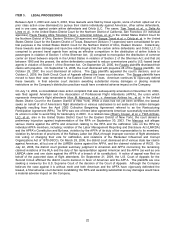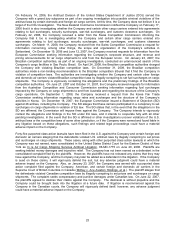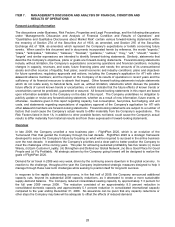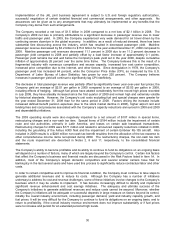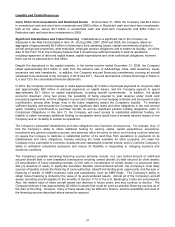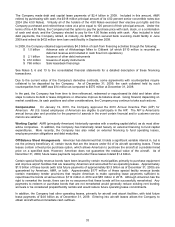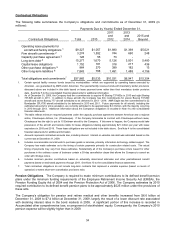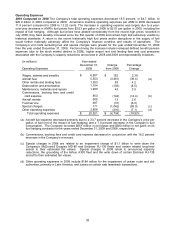American Airlines 2009 Annual Report Download - page 31
Download and view the complete annual report
Please find page 31 of the 2009 American Airlines annual report below. You can navigate through the pages in the report by either clicking on the pages listed below, or by using the keyword search tool below to find specific information within the annual report.
28
ITEM 7. MANAGEMENT'S DISCUSSION AND ANALYSIS OF FINANCIAL CONDITION AND
RESULTS OF OPERATIONS
Forward-Looking Information
The discussions under Business, Risk Factors, Properties and Legal Proceedings, and the following discussions
under ―Management's Discussion and Analysis of Financial Condition and Results of Operations‖ and
―Quantitative and Qualitative Disclosures about Market Risk‖ contain various forward-looking statements within
the meaning of Section 27A of the Securities Act of 1933, as amended, and Section 21E of the Securities
Exchange Act of 1934, as amended, which represent the Company's expectations or beliefs concerning future
events. When used in this document and in documents incorporated herein by reference, the words "expects,"
"plans," "anticipates," ―indicates,‖ ―believes,‖ ―forecast,‖ ―guidance,‖ ―outlook,‖ ―may,‖ ―will,‖ ―should,‖ ―seeks,‖
―targets‖ and similar expressions are intended to identify forward-looking statements. Similarly, statements that
describe the Company’s objectives, plans or goals are forward-looking statements. Forward-looking statements
include, without limitation, the Company’s expectations concerning operations and financial conditions, including
changes in capacity, revenues, and costs; future financing plans and needs; the amounts of its unencumbered
assets and other sources of liquidity; fleet plans; overall economic and industry conditions; plans and objectives
for future operations; regulatory approvals and actions, including the Company’s application for ATI with other
oneworld alliance members; and the impact on the Company of its results of operations in recent years and the
sufficiency of its financial resources to absorb that impact. Other forward-looking statements include statements
which do not relate solely to historical facts, such as, without limitation, statements which discuss the possible
future effects of current known trends or uncertainties, or which indicate that the future effects of known trends or
uncertainties cannot be predicted, guaranteed or assured. All forward-looking statements in this report are based
upon information available to the Company on the date of this report. The Company undertakes no obligation to
publicly update or revise any forward-looking statement, whether as a result of new information, future events, or
otherwise. Guidance given in this report regarding capacity, fuel consumption, fuel prices, fuel hedging, and unit
costs, and statements regarding expectations of regulatory approval of the Company’s application for ATI with
other oneworld members are forward-looking statements. Forward-looking statements are subject to a number of
factors that could cause the Company’s actual results to differ materially from the Company’s expectations. The
Risk Factors listed in Item 1A, in addition to other possible factors not listed, could cause the Company's actual
results to differ materially from historical results and from those expressed in forward-looking statements.
Overview
In late 2009, the Company unveiled a new business plan – FlightPlan 2020, which is an evolution of the
Turnaround Plan that guided the Company through the last decade. FlightPlan 2020 is a strategic framework
developed to secure the Company’s future by focusing on what will be required to succeed in the airline business
over the next decade. It establishes the Company’s priorities and a clear path to better position the Company to
meet the challenges of the coming years. This plan for achieving sustained profitability has five tenets: (i) Invest
Wisely, (ii) Earn Customer Loyalty, (iii) Strengthen and Defend our Global Network, (iv) Be a Good Place for Good
People and (v) Fly Profitably. All strategic actions by the Company going forward will be designed to realize the
goals of FlightPlan 2020.
Demand for air travel in 2009 was very weak, driven by the continuing severe downturn in the global economy. In
reaction to the challenge, throughout the year the Company implemented strategic measures designed to help it
manage through these near-term challenges while seeking to position itself for long-term success.
In response to the rapidly deteriorating economy, in the first half of 2009, the Company announced additional
capacity cuts, beyond its substantial 2008 capacity reductions, as it attempted to create a more sustainable
supply-demand balance. The Company reduced consolidated seating capacity by approximately 7.3 percent for
the full year 2009 versus 2008. The reduction consisted of an approximately 8.5 percent reduction in
consolidated domestic capacity and approximately 5.1 percent reduction in consolidated international capacity
compared to the year ending December 31, 2008. No assurance can be given that any capacity reductions or
other steps the Company may take will be adequate to offset the effects of reduced demand.






